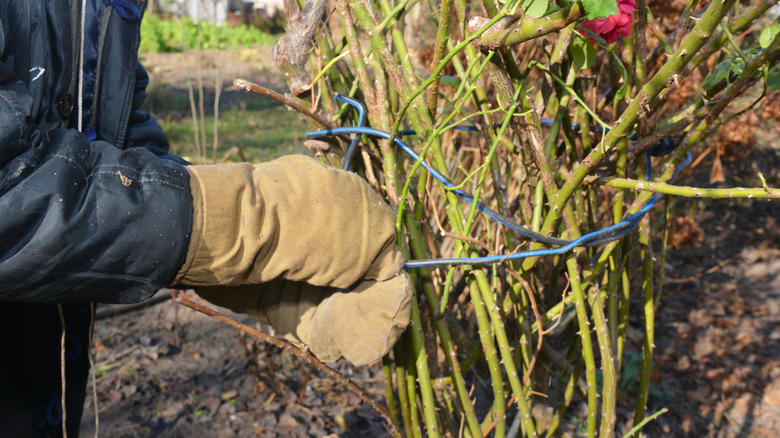How To Protect Your Climbing Rose Plants From Frost During The Winter
For gardeners, all the stunning cultivars of the climbing rose (Rosa setigera) are unique in the sense that they do more than just please your senses with stunning colors and smells. After all, you can also grow climbing roses for gorgeous towering blooms over walls and fences, and make these otherwise dull elements in your yard vibrantly come to life. Since these precious members of your garden add so much to your life, it is only natural that you would want them to survive the winters and come back stronger next spring. In the case of climbing roses, although there are other steps you need to prepare them for cold (such as stopping their feed at the right time), insulating their canes and crown with soil or burlap is the most crucial step that you can not ignore.
Most climbing roses, just like their upright buddies, are commercially grown via grafting, which makes them more vulnerable to being damaged by the cold. Since the portion above the ground is not naturally supported by its own roots, any severe damage to the grafted union can kill the plant. Moreover, more than the cold itself, it is the freeze-thaw cycle that can really hurt your climbing roses. The tender canes of your climbing rose can crack due to this repeated freezing and thawing, leading to entry of germs and pests. This is why the primary aim of protecting your climbing rose from winter is keeping the cold as uniform as possible throughout the season.
Insulate the canes of your climbing rose with burlap or soil
If you live in an area where winds and temperatures are not too extreme, wrapping your climbing rose's canes in burlap or evergreen bough, such as pine or fir, would be enough. Tie the canes together with a twine before you wrap them up and mound the soil at the base of the plant to add further insulation. Mounding the soil (about 10 to 12 inches) is crucial for protecting the roots and the crown from the cold and the freeze-thaw cycles.
However, if you live in a region where winters are harsh, you may have to cover the entire plant with soil to save it from the cold. Make sure you wait a few days after freezing temperatures before insulating the ground to make sure the plant enters dormancy first. Take your climbing rose off its support, tie the canes together, and peg the plant down to the ground. Make sure the stem doesn't break by arching it from the base. Insert stakes into the ground to pin the canes and cover the entire plant with soil.
The steps you take to protect your climbing rose also depends on the location of the rose itself. If the rose is growing along a wall in a sheltered part of the house, it would naturally need far less protection that one growing along a trellis in the middle of your garden. Furthermore, although the climbing rose is hardy through USDA Zones 4 through 8, a variety that is more cold-hardy — such as this easy-care variety our professional gardener recommends ('Zephirine Drouhin') – is far easier for overwintering in a lower zone.
Necessary steps to take before overwintering your climbing rose
Although a lot of winter protection needs to happen once the temperatures begin to drop, you also need to make sure that your roses are prepared for the change beforehand. For this to happen, make sure you stop any pruning or fertilizing after summer. August should be the last month of fertilizing, since any new growth would not have the time to harden off before winter sets in. Similarly, by mid-summer, you should have your climbing rose pruned off as well. Make sure you prune the flowering canes closer to roots, once the blooms have faded and stopped, to give any new growth enough time for hardening off. Pruning the plant before the winter arrives will keep it healthy and safe from fungal diseases.
Just because your plant is entering the cold, dormant season, does not mean it doesn't need to stay hydrated. Give the plant a good drink after the first frost when the ground is still unfrozen and able to accept moisture. Remove all the debris from the base of the plant as it may be harboring fungal spores, which you don't want overwintering alongside your roses.


